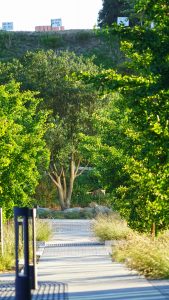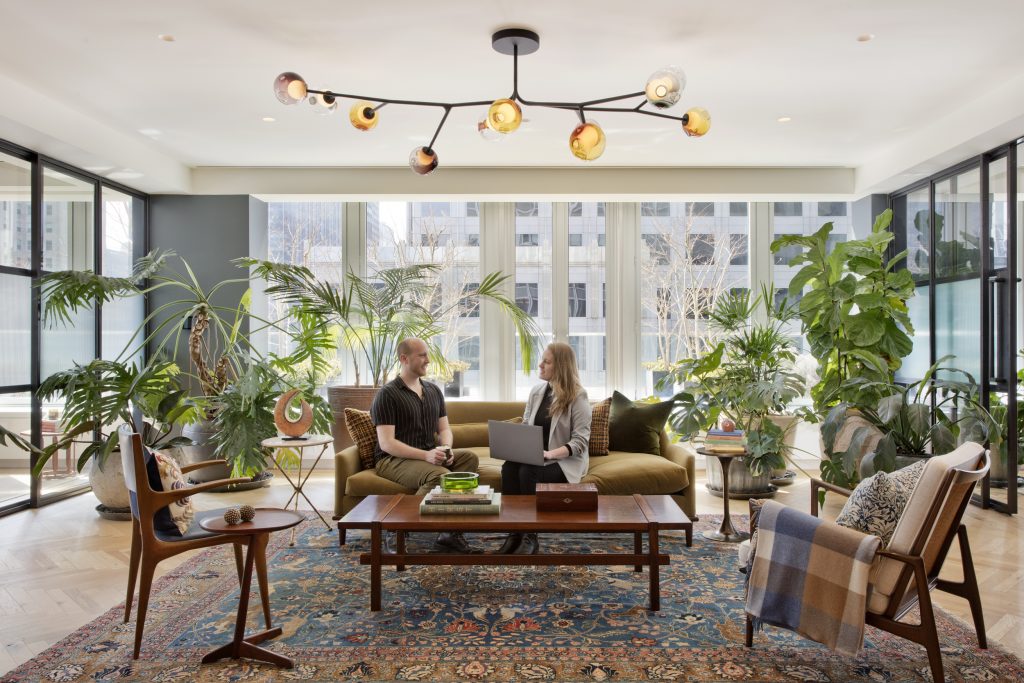McCullough Landscape Architecture’s David McCullough shares how your outside footprint design can punch above its weight when it comes to supporting your organization’s office sustainability objectives – and look good, too!
In today’s eco-conscious world, a company’s commitment to sustainability often stretches beyond the confines of its interior walls. Extending a thoughtfully designed workspace into its surrounding outdoor spaces can help an organization not only achieve their sustainability goals, but also foster a culture of environmental stewardship that supports the well-being of employees and the local ecosystem.
Leveraging landscape design to support office sustainability benchmarks isn’t simply about fulfilling requirements. It’s about developing strategic approaches to future-proofing businesses.
As climate change continues to place businesses at risk for droughts, floods, wildfires, and other environmental disasters, investing wisely in these improvements can also yield significant returns — not only in terms of direct energy savings that help the planet, but in the form of more subtle bonuses, such as securing top talent and business.
Strategic Landscaping for Sustainability
Most office sustainability programs focus on the reduction of two critical areas: embodied carbon—materials used during construction—and operational carbon, or emissions from building operations. In some cases, it’s a legal mandate, such as California’s CALGreen Mandatory Measures for Embodied Carbon Reduction program that requires certain projects to complete a whole building life cycle assessment (WBLCA) demonstrating 10% lower embodied carbon emission. As companies increasingly move towards achieving certifications like LEED and fulfilling Net-Zero goals, landscape design plays a crucial role in meeting both objectives.

For companies that are ready to adapt to materials that carry a lower carbon footprint, there’s an opportunity to bring form to function. Using landscaping strategies that embrace the natural environment can enhance the aesthetics of the workspace while reinforcing a brand image as an innovative, conscientious business. The selection of plants can make a statement about a company’s values, such as being efficient in resource use and innovation, adaptive and able to thrive among challenges, or operating a holistically sustainable organization.
Common Mistakes in Sustainable Landscape Design
It’s easy to prioritize aesthetics or immediate cost savings over long-term sustainability benefits, but value engineering a project could be a missed opportunity to address issues before they add up to an expensive mistake. Reducing the number of plants to save water and upkeep, for example, may seem like a smart way to cut costs, but trees are one of the most cost-effective solutions for sustainability.
Larger, mature trees, while initially more costly, provide immediate benefits in terms of shade and aesthetics, leading to energy savings and enhanced property values. Native and drought-resistant plants minimize water usage and maintenance, while strategically placed trees can reduce cooling costs by moderating building temperatures. Implementing xeriscaping—or plants that require very little irrigation—and designing rainwater capture systems to sustain these landscapes can further reduce a site’s operational footprint. Consider an asphalt parking lot: without any trees offering shade as a natural protectant, it can lead to extreme temperatures that increase cooling costs. Having a tree can bring the temperature down from over 100 degrees to the 90s, while adding softscape will help cool the space in hotter months.
Similarly, excessive hardscaping can contribute to heat accumulation and stormwater runoff issues, impacting both the local environment and the comfort of office occupants. Embracing less expensive softscape options, such as mulch and decomposed granite instead of extensive hardscaping, provides cost-effective solutions for larger areas, contributing to cooling that reduces the reliance on air conditioning and stormwater management without substantial investments.

Maximizing the Impact of Outdoor Spaces
Outdoor design shouldn’t only focus on functional and environmental aspects, but takes into account employee engagement and connects to a brand’s aesthetic. Effective landscape strategies and designs can amplify an office’s sustainability profile, becoming a reflection of its brand reputation. Companies that have innovative, environmentally responsible workspaces stand out in today’s competitive job market, attracting top talent and business that comes with it.
When planning these spaces, connectivity between indoor and outdoor areas is crucial. Ensuring seamless access and incorporating similar design elements can enhance the overall usability and appeal of the outdoor environment. Providing varied outdoor settings—from shaded meeting areas to casual lounging spots—encourages year-round usage and considers the organization’s identity and values.
 Going Above and Beyond
Going Above and Beyond
Designing for sustainability should not be an overt statement but rather a subtle integration of nature and functionality. Regions like San Diego, for example, are facing unique challenges like increased rainfall and heatwaves, demanding adaptable designs that manage extreme weather while providing comfortable and usable outdoor spaces are crucial.
Thoughtfully integrating sustainable practices with aesthetic considerations can enhance employee satisfaction, reduce a company’s environmental impact, and affirm their commitment to sustainability, all while setting a new standard in corporate responsibility. In doing so, they not only meet but exceed their sustainability goals, demonstrating that true commitment to the environment begins right outside their doors.
Want to read more about sustainability in the workplace? Check out:
Embracing Sustainability in the Workplace through Furniture Upcycling



